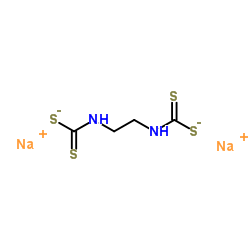Nabam

Nabam structure
|
Common Name | Nabam | ||
|---|---|---|---|---|
| CAS Number | 142-59-6 | Molecular Weight | 256.343 | |
| Density | 1.342 g/mL at 25 °C(lit.) | Boiling Point | 308.2ºC at 760 mmHg | |
| Molecular Formula | C4H6N2Na2S4 | Melting Point | 78-81ºC | |
| MSDS | Chinese USA | Flash Point | 140.2ºC | |
| Symbol |


GHS07, GHS09 |
Signal Word | Warning | |
|
[Hepatic microsomal monoxygenase inhibition by nabam in the rat (author's transl)].
Toxicol. Eur. Res. 3(6) , 285-91, (1981) Nabam (fungicide dithiocarbamate) has been incorporated with the diet of rats during six months (the doses were: 0, 10, 50, 100, 500, 1000 and 2000 ppm). It decreases significantly the hepatic microsomal enzymes activity (aniline hydroxylase and aminopyrine N... |
|
|
Ultrastructural and histological study of degenerative changes in the antennal glands, hepatopancreas, and midgut of grass shrimp exposed to two dithiocarbamate biocides.
J. Invertebr. Pathol. 41(3) , 281-300, (1983) The histological and ultrastructural alterations observed in the antennal glands, hepatopancreas, and midgut of grass shrimp exposed to either a 50% potassium dimethyldithiocarbamate biocide (Busan-85; 5–60 ppb) for 14 days, or to a different biocide, compose... |
|
|
Studies on the mechanism of nabam- and zineb-induced inhibition of the hepatic microsomal monooxygenases of the male rat.
Toxicol. Appl. Pharmacol. 81(3 Pt 1) , 460-8, (1985) In vitro effects of the ethylene bis-dithiocarbamate fungicides, nabam and zineb, on the hepatic microsomal monooxygenases of male rats were examined. Incubation of nabam and zineb with hepatic microsomes, without NADPH, leads to an inhibition of the metaboli... |
|
|
[Effects of the fungicides, nabam and zineb, on oxygenase activity and thiolate content in rat liver microsomes].
Food Cosmet. Toxicol. 19(6) , 761-3, (1981)
|
|
|
Determination of nabam fungicide in crops by liquid chromatography with postcolumn reaction detection.
J. Assoc. Off. Anal. Chem. 74(2) , 384-8, (1991) The ethylenebisdithiocarbamate (EBDC) fungicide, nabam, was determined in several crop matrixes using liquid chromatography with postcolumn reaction detection. After separation by micellar liquid chromatography, nabam (EBDC sodium salt) was acid hydrolyzed to... |
|
|
Photodegradation and flow-injection determination of dithiocarbamate fungicides in natural water with chemiluminescence detection.
Anal. Sci. 25(3) , 395-400, (2009) A simple and rapid flow-injection method is reported for the determination of dithiocarbamate fungicides (maneb, nabam and thiram) based on chemiluminescence detection. The method involves the photodegradation of dithiocarbamate fungicides via UV light in an ... |
|
|
Urinary excretion of ethylenethiourea and kidney morphology in rats after continuous oral exposure to nabam or ethylenethiourea.
Arch. Toxicol. 65(5) , 381-5, (1991) Nabam, an ethylenebisdithiocarbamate (EBDC), is an agricultural fungicide. Ethylenethiourea (ETU), widely used in the rubber industry, is a degradation and byproduct of metabolism and of storage and production of EBDCs. Kidney function and morphology, and uri... |
|
|
Effects of minute doses of ethylenebisdithiocarbamate disodium salt (nabam) and its degradative products on connective tissue envelopes of the notochord in Xenopus: an ultrastructural study.
Cytobios. 48(194-195) , 175-84, (1986) The fungicide ethylenebisdithiocarbamate disodium salt (nabam) at 40 or 100 micrograms/l has deleterious effects on the survival of Xenopus laevis embryos. The tissues of the notochordal enveloping layer show definite alterations at the ultrastructural level.... |
|
|
Effects of nabam on developing Xenopus laevis embryos: minimum concentration, biological stability, and degradative products.
Arch. Environ. Contam. Toxicol. 15(6) , 637-45, (1986)
|
|
|
Residues of EBDC fungicides and ETU in experimental and commercial beverages (beer and wine).
J. Environ. Sci. Health B 23(2) , 179-88, (1988) Residues of EBDC (ethylenebisdithiocarbamate) fungicides and ETU (ethylenethiourea; 2-imidazolidinethione) were monitored in beers and wines from different locations. No EBDC residues were detected in any of the samples examined. Concerning the ETU residues, ... |